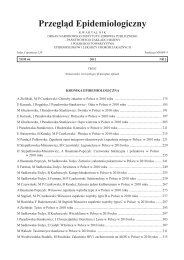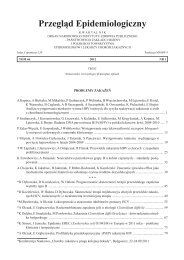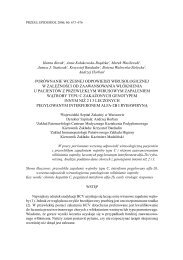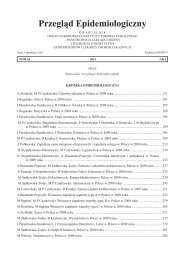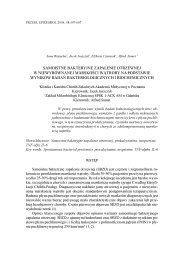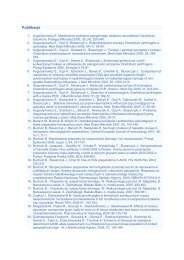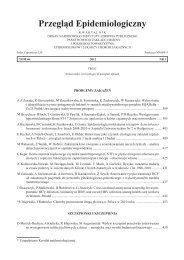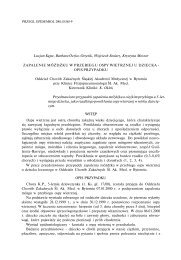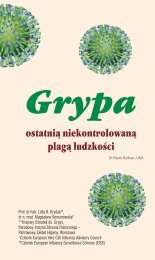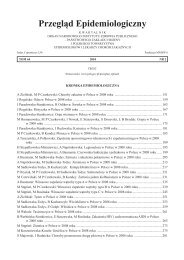Rok 2011, tom 65, nr 4 - Państwowy Zakład Higieny
Rok 2011, tom 65, nr 4 - Państwowy Zakład Higieny
Rok 2011, tom 65, nr 4 - Państwowy Zakład Higieny
Create successful ePaper yourself
Turn your PDF publications into a flip-book with our unique Google optimized e-Paper software.
Nr 4<br />
cysts of Entamoeba coli occurred more often in children<br />
having constant contact with animals at home.<br />
Detailed results are presented in tables I and II.<br />
Table II. Determined mixed infestations<br />
Tabela II. Stwierdzone inwazje mieszane w badanych<br />
próbkach kału- liczba dodatnich próbek i odsetek<br />
(n=998)<br />
Number of samples<br />
Determined species<br />
(n=998)<br />
n %<br />
Giargia intestinalis + Enterobius vermicularis 5 0.5<br />
Ascaris lumbricoides + Blastocystis hominis 5 0.5<br />
Isospora belli + Entoamoeba coli 6 0.6<br />
Cystoisospora + Entoamoeba coli 2 0.2<br />
Enterobius vermicularis + Blastocystis hominis 8 0.8<br />
Giargia intestinalis +Blastocystis hominis 25 2.5<br />
In the questionnaires, 347 patients did not report<br />
any symp<strong>tom</strong>s of parasitic infestation, 255 persons<br />
reported one symp<strong>tom</strong>, 160 subjects noted two symp<strong>tom</strong>s,<br />
95 people listed three, 81 – four, 40 – five, and<br />
20 patients – 6 symp<strong>tom</strong>s. The most common symp<strong>tom</strong><br />
was nocturnal restlessness, followed by skin lesions. In<br />
45 patients who had not reported any symp<strong>tom</strong>s in the<br />
questionnaire, the presence of Entoamoeba coli cysts<br />
(12 patients), Blastocystis hominis cysts (24 subjects)<br />
and Giargia lamblia dispersive forms (9 patients)<br />
(mixed invasion of G.intestinalis + B . hominis in 5<br />
patients) was found.<br />
Table III. Frequency of reported symp<strong>tom</strong>s<br />
Tabela III. Częstotliwość zgłaszania poszczególnych objawów<br />
ogólnych przez badane dzieci<br />
Number of applications<br />
Symp<strong>tom</strong><br />
(n=998)<br />
n %<br />
Digestive disorders 110 11.02<br />
Skin lesions 225 22.54<br />
Nocturnal restlessness 270 27.05<br />
Dark circles under eyes 180 18.03<br />
Earthy complexion 112 11.22<br />
Excessive excitability 172 17.23<br />
Shortness of breath and a cough 130 13.02<br />
Anemia 77 7.71<br />
Abnormal stools 164 16.43<br />
Genital and anal itching 145 14.53<br />
The survey revealed that 475 patients owned pets<br />
(dogs – 51.2%, cats – 31.7%, rabbits – 6.3% hamsters<br />
– 4.9%, turtles – 1.6%, mice –1.6 %, degus – 0.9%, chinchillas<br />
– 0.9%, parrots – 0.9%). Of these, 315 subjects<br />
(66.3%) reported the presence of at least one symp<strong>tom</strong><br />
suggestive of a parasitic infection. In the group of pet<br />
owners, positive results were obtained in 113 cases<br />
Parasitological stool examination 601<br />
(23.8%), whereas the average for non-pet owners was<br />
19.7% (103 cases). Both groups were characterized<br />
by a similar composition of parasite species. Detailed<br />
results for pet owners and non-owners are presented in<br />
tables IV and V.<br />
Table IV. Correlation between the percentage of positive<br />
samples and the number of symp<strong>tom</strong>s reported by<br />
non-pet owners<br />
Tabela IV. Odsetek prób dodatnich w stosunku do liczby<br />
zgłaszanych objawów u osób nieposiadających<br />
zwierząt w domu<br />
Non-pet owners Number of<br />
reports<br />
Number of positive samples<br />
n %<br />
no symp<strong>tom</strong>s reported 187 25 13.4<br />
1 symp<strong>tom</strong> reported 155 25 16.1<br />
2 symp<strong>tom</strong>s reported 85 18 21.1<br />
3 symp<strong>tom</strong>s reported 25 9 36<br />
4 symp<strong>tom</strong>s reported 41 15 36.5<br />
5 symp<strong>tom</strong>s reported 25 7 28<br />
6 symp<strong>tom</strong>s reported 5 4 80<br />
Table V. Correlation between the percentage of positive<br />
samples and the number of symp<strong>tom</strong>s reported by<br />
pet owners<br />
Tabela V. Odsetek prób dodatnich w stosunku do liczby zgłaszanych<br />
objawów u osób posiadających zwierzęta<br />
w domu<br />
Pet owners Number of<br />
reports<br />
Number of positive samples<br />
n %<br />
no symp<strong>tom</strong>s reported 160 20 12.5<br />
1 symp<strong>tom</strong> reported 100 21 21<br />
2 symp<strong>tom</strong>s reported 75 15 20<br />
3 symp<strong>tom</strong>s reported 70 17 24.3<br />
4 symp<strong>tom</strong>s reported 40 18 45<br />
5 symp<strong>tom</strong>s reported 15 10 66.6<br />
6 symp<strong>tom</strong>s reported 15 12 80<br />
DISCUSSION<br />
Parasitic infections represent approximately 25%<br />
of all infectious diseases worldwide (1, 8, 9, 10) but<br />
are conveniently associated with countries of relatively<br />
low levels of hygiene and warm climate, such as sub-<br />
-Saharan Africa, Asia and South America. Prevalence<br />
of parasitic infections in Europe and North America<br />
is estimated at 1,5% to 25% depending on region and<br />
examined population (1, 11, 12). The situation in Poland<br />
does not differ from the European average, and is<br />
dependent on a selected group of subjects. (13, 14, 15)<br />
In the present study the presence of parasites was<br />
determined in 21.6% of examined children. Protozoan<br />
infections accounted for 97.3% of all infestations,<br />
including mixed infections, whereas only helminths



